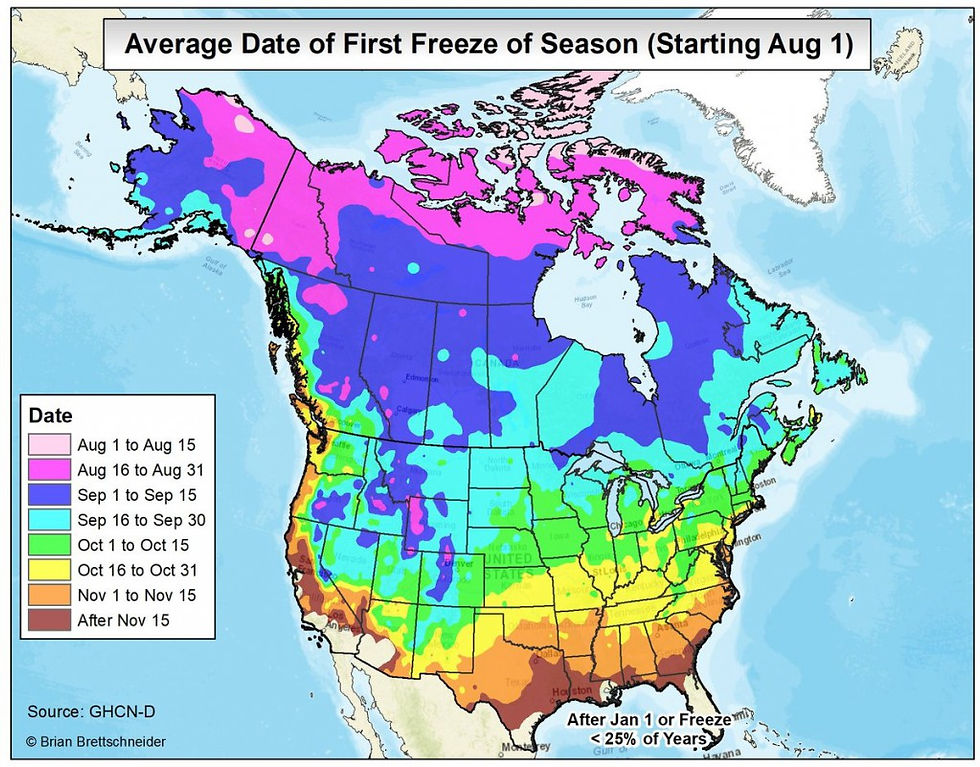Fall Checklist Around the House and Garden
- Krystle
- Oct 6, 2020
- 4 min read
Updated: Oct 17, 2024
Summer has flashed before our very eyes and if you’re like me, you’ve used quarantine as the perfect opportunity to improve your garden. With summer slowly coming to a dreadful end, don’t be so quick to put away your gardening tools just yet- the fun has just begun! This is your chance to seed crops that actually thrive in fall’s cool temperature. Preparing for your fall garden now will ensure that you have the ultimate harvest for later. Read below on your Fall checklist for your garden.
Tidy Up Your Garden
Like every other season, fall calls for a new canvas. Nothing feels better than making sure you have a clear space to welcome in some fresh crops. If you’ve been maintaining your garden all summer, this shouldn’t take too long. On the other hand, if you’re like me, there will be a little freshening up to do!
Prepare your garden by first removing anything that is ready to be harvested or that is no longer performing well.
Don’t forget to pick up any fallen fruits- doing this will prevent you from attracting any pests.
Finally, pull any weeds so they don’t steal moisture and nutrients from your new plants. Nothing is worse than having a beautiful garden be taken over by a sea of unwanted weeds.
Prepare and Replenish Your Soil
Throughout the summer, your plants extract all of the nutrients that come from the soil. Now
it’s time to replenish them so that they’re ready to bloom nice and big next season.

If your mulch can’t be re-used for the fall, replace it with a fresh layer.
Fluff up your soil by using a garden fork or cultivator to loosen the compacted soil. This will create room for new roots to freely move around and allows for easy water access.
Add about two to three inches of fresh compost so that there is enough to decompose over winter and carry into the spring.
Nurture Growth Bio-Fertilizer can be used by itself or with compost to provide your soil with all the nutrients it needs.
The great thing about Nurture Growth biofertilizer is that it’s 100% certified organic, filled with microorganisms, environmentally friendly, and safe to use.
Check for Your First Frost Date
The best way to plan for the season change is to make sure you know your first frost date. Wait, did I just say...frost?! I know. It’s hard to think about that cold weather now, but trust me, you’ll want to know this for later! Your first frost date will likely be when you’ll experience your first freeze of the fall. If you’re living in a cold environment it’ll be sooner, which means the best time to start seeding is late July to August! Lucky for you, you’re right on schedule. Check your plant’s “days to maturity” and count backwards from your frost date.
An easy trick is to count an extra 2 weeks back- as the days begin to shorten, this ensures that your vegetables are getting all the time they need to grow.

If you’re a little tight on time, don’t worry, just make sure to choose varieties with shorter maturity dates when direct seeding. Pelleted seeds can also be found for some vegetables that take longer to grow; they speed up germination up to 50% and retain water more efficiently. It will definitely save you the hassle of that extra TLC time!
Plant your Seeding
Time to get digging! Plant your seeds deeper in the fall than you would in the spring. While the ground is still warm in the fall, it’s important to plant seed where the soil is cool and moist.

Tip: don’t be afraid to plant them deeper than what their package suggests. An extra 1-2 inches will get the job done!
If your garden isn’t ready for seeding just yet, go ahead and plant your seeds indoors. This works perfectly for leafy greens and brassica vegetables that can be easily transplanted outside once you’re ready. Root crops and peas however are not suitable for this and should be directly seeded instead.
Repot Your Houseplants
Although your vacation may have been cancelled this year, at least your houseplants got a summer trip to the backyard. With all that extra sunlight, they probably resulted in some crazy growth! Now is the perfect time to repot them into a larger container so they can settle in their new home before another weather change hits.

Unsure of when to repot? Here are a few easy giveaways:
Your plant has outgrown its home and is pushing itself out of its container
You’ve noticed slower or stunted growth
The roots are dangling out of the drainage hole
When transplanting, make sure to provide them with some fresh soil!
With the hot weather coming to an end, we hope you enjoyed your summer gardening and are ready to embrace the next chapter! If you have any questions or tips you’d like to share, feel free to contact us at info@nurturegrowthbio.com!
Blogger Biography

Krystle is a Ryerson University student majoring in Marketing and minoring in French. As a business student, she has always had a huge entrepreneurial curiosity with the hopes of one day running her own business. With a passion for environmental activism, she is always looking for ways to educate herself and others in the fight against climate change. She is upbeat, energetic and loves rollerblading, hot yoga and spending time with her little dog Zeus.



















Presently analysts say they've addressed the sub-atomic secret of how these uncommon blossoms get their dull shades black dahlia flower. Blossom variety in not entirely settled by a combination of plant metabolites called flavonoids.